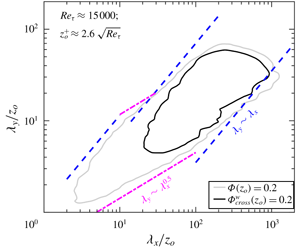Crossref Citations
This article has been cited by the following publications. This list is generated based on data provided by
Crossref.
2020.
Characteristics of wall-attached motions in open channel flows.
Physics of Fluids,
Vol. 32,
Issue. 5,
p.
055110.
Chandran, Dileep
Monty, Jason P.
and
Marusic, Ivan
2020.
Spectral-scaling-based extension to the attached eddy model of wall turbulence.
Physical Review Fluids,
Vol. 5,
Issue. 10,
Hwang, Jinyul
Lee, Jae Hwa
and
Sung, Hyung Jin
2020.
Statistical behaviour of self-similar structures in canonical wall turbulence.
Journal of Fluid Mechanics,
Vol. 905,
Issue. ,
Li, Xuebo
Wang, Guohua
and
Zheng, Xiaojing
2021.
Logarithmic energy profile of the streamwise velocity for wall-attached eddies along the spanwise direction in turbulent boundary layer.
Physics of Fluids,
Vol. 33,
Issue. 10,
Choi, Yun Kyung
Lee, Jae Hwa
and
Hwang, Jinyul
2021.
Direct numerical simulation of a turbulent plane Couette-Poiseuille flow with zero-mean shear.
International Journal of Heat and Fluid Flow,
Vol. 90,
Issue. ,
p.
108836.
Deshpande, Rahul
de Silva, Charitha M.
Lee, Myoungkyu
Monty, Jason P.
and
Marusic, Ivan
2021.
Data-driven enhancement of coherent structure-based models for predicting instantaneous wall turbulence.
International Journal of Heat and Fluid Flow,
Vol. 92,
Issue. ,
p.
108879.
Deshpande, Rahul
Monty, Jason P.
and
Marusic, Ivan
2021.
Active and inactive components of the streamwise velocity in wall-bounded turbulence.
Journal of Fluid Mechanics,
Vol. 914,
Issue. ,
Deshpande, Rahul
and
Marusic, Ivan
2021.
Characterising Momentum Flux Events in High Reynolds Number Turbulent Boundary Layers.
Fluids,
Vol. 6,
Issue. 4,
p.
168.
Brethouwer, Geert
2022.
Turbulent flow in curved channels.
Journal of Fluid Mechanics,
Vol. 931,
Issue. ,
Wang, Longwei
Pan, Chong
Wang, Jinjun
and
Gao, Qi
2022.
Statistical signatures of component wall-attached eddies in proper orthogonal decomposition modes of a turbulent boundary layer.
Journal of Fluid Mechanics,
Vol. 944,
Issue. ,
Hwang, Jinyul
and
Lee, Jae Hwa
2022.
Meandering features of wall-attached structures in turbulent boundary layer.
Physical Review Fluids,
Vol. 7,
Issue. 11,
Deshpande, Rahul
de Silva, Charitha M.
and
Marusic, Ivan
2023.
Evidence that superstructures comprise self-similar coherent motions in high Reynolds number boundary layers.
Journal of Fluid Mechanics,
Vol. 969,
Issue. ,
Cui, G.
and
Jacobi, I.
2023.
Prediction of the phase difference between large-scale velocity and Reynolds stress fluctuations in wall turbulence.
Journal of Fluid Mechanics,
Vol. 969,
Issue. ,
Abootorabi, Seyedalireza
and
Zare, Armin
2023.
Model-based spectral coherence analysis.
Journal of Fluid Mechanics,
Vol. 958,
Issue. ,
Huang, Yu-Ying
and
Tsai, Christina W.
2023.
Modeling suspended sediment transport under the influence of attached eddies in turbulent flows.
Stochastic Environmental Research and Risk Assessment,
Vol. 37,
Issue. 9,
p.
3451.
Baars, Woutijn J.
Dacome, Giulio
and
Lee, Myoungkyu
2024.
Reynolds-number scaling of wall-pressure–velocity correlations in wall-bounded turbulence.
Journal of Fluid Mechanics,
Vol. 981,
Issue. ,
Li, Xuebo
Hu, Lan
Hu, Xin
and
Liu, Wanting
2024.
Scaling of vertical coherence and logarithmic energy profile for wall-attached eddies during sand and dust storms.
Journal of Fluid Mechanics,
Vol. 996,
Issue. ,
Cheng, Cheng
and
Fu, Lin
2024.
Comparisons between the first- and second-order spectral stochastic estimations in investigating the multiphysics couplings for a supersonic turbulent channel flow.
Physical Review Fluids,
Vol. 9,
Issue. 10,
He, Xibo
Liu, Hongyou
and
Zheng, Xiaojing
2024.
Wall-attached structure characteristics of flow and dust concentration fields in high-Reynolds-number particle-laden flows.
Journal of Fluid Mechanics,
Vol. 986,
Issue. ,

 $u$) component and use it to test the notion of self-similarity in turbulent boundary layers. The primary focus is on the cross-spectrum (
$u$) component and use it to test the notion of self-similarity in turbulent boundary layers. The primary focus is on the cross-spectrum ( $\unicode[STIX]{x1D6F7}_{cross}^{w}$) measured across the logarithmic (
$\unicode[STIX]{x1D6F7}_{cross}^{w}$) measured across the logarithmic ( $z_{o}$) and near-wall (
$z_{o}$) and near-wall ( $z_{r}$) wall-normal locations, providing the energy distribution across the range of streamwise (
$z_{r}$) wall-normal locations, providing the energy distribution across the range of streamwise ( $\unicode[STIX]{x1D706}_{x}$) and spanwise (
$\unicode[STIX]{x1D706}_{x}$) and spanwise ( $\unicode[STIX]{x1D706}_{y}$) wavelengths (or length scales) that are coherent across the wall-normal distance.
$\unicode[STIX]{x1D706}_{y}$) wavelengths (or length scales) that are coherent across the wall-normal distance.  $\unicode[STIX]{x1D6F7}_{cross}^{w}$ may thus be interpreted as a wall-filtered subset of the full 2-D
$\unicode[STIX]{x1D6F7}_{cross}^{w}$ may thus be interpreted as a wall-filtered subset of the full 2-D  $u$-spectrum (
$u$-spectrum ( $\unicode[STIX]{x1D6F7}$), the latter providing information on all coexisting eddies at
$\unicode[STIX]{x1D6F7}$), the latter providing information on all coexisting eddies at  $z_{o}$. To this end, datasets comprising synchronized two-point
$z_{o}$. To this end, datasets comprising synchronized two-point  $u$-signals at
$u$-signals at  $z_{o}$ and
$z_{o}$ and  $z_{r}$, across the friction Reynolds number range
$z_{r}$, across the friction Reynolds number range  $Re_{\unicode[STIX]{x1D70F}}\sim O(10^{3}){-}O(10^{4})$, are analysed. The published direct numerical simulation (DNS) dataset of Sillero et al. (Phys. Fluids, vol. 26 (10), 2014, 105109) is considered for low-
$Re_{\unicode[STIX]{x1D70F}}\sim O(10^{3}){-}O(10^{4})$, are analysed. The published direct numerical simulation (DNS) dataset of Sillero et al. (Phys. Fluids, vol. 26 (10), 2014, 105109) is considered for low- $Re_{\unicode[STIX]{x1D70F}}$ analysis, while the high-
$Re_{\unicode[STIX]{x1D70F}}$ analysis, while the high- $Re_{\unicode[STIX]{x1D70F}}$ dataset is obtained by conducting synchronous multipoint hot-wire measurements. High-
$Re_{\unicode[STIX]{x1D70F}}$ dataset is obtained by conducting synchronous multipoint hot-wire measurements. High- $Re_{\unicode[STIX]{x1D70F}}$ cross-spectra reveal that the wall-attached large scales follow a
$Re_{\unicode[STIX]{x1D70F}}$ cross-spectra reveal that the wall-attached large scales follow a  $\unicode[STIX]{x1D706}_{y}/z_{o}\sim \unicode[STIX]{x1D706}_{x}/z_{o}$ relationship more closely than seen for
$\unicode[STIX]{x1D706}_{y}/z_{o}\sim \unicode[STIX]{x1D706}_{x}/z_{o}$ relationship more closely than seen for  $\unicode[STIX]{x1D6F7}$, where this self-similar trend is obscured by coexisting scales. The present analysis reaffirms that a self-similar structure, conforming to Townsend’s attached eddy hypothesis, is ingrained in the flow.
$\unicode[STIX]{x1D6F7}$, where this self-similar trend is obscured by coexisting scales. The present analysis reaffirms that a self-similar structure, conforming to Townsend’s attached eddy hypothesis, is ingrained in the flow.